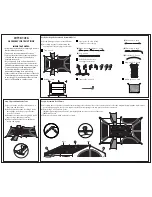
Step 3: Position Fly and Attach Leg Poles
1) With roof frame constructed, unfold and position the fly on the tent as shown below, label at the front.
2) With 2 persons, begin at one side of the roof frame and attach leg poles (B) into the connectors (fig.1). Place bottom of the legs onto
the corresponding pins along the perimeter of the tent floor (fig.2).
3) Wrap the hook and loop fasteners, at the corners of the fly, around the frame (fig.3).
4) Attach the plastic s-hooks on the fly to the d-rings on each leg pole (fig.4).
5) Attach the remaining leg poles (B) repeating points 2 through 4.
6) Inserting a stake through the remaining stake loops along the perimeter of the tent (fig.5).
Disassembly
Packing the Tent
1) To take down the tent, disassemble in
reverse order.
2) Remove accessories (if included)
3) Remove and fold fly.
4) Be sure to leave doors and windows
unzipped to avoid zipper damage.
5) Remove stakes with hammers or stake
puller. DO NOT pull on tent.
6) Carefully disengage poles from pins. Push
poles away from you through the sleeves
to minimize risk of damage to tent or poles.
7) Keep poles and stakes together in bags
provided.
3) Lay pole bag at opposite end from door.
Tightly roll bag, skin and fly forcing air
through unzipped door.
4) Secure with ties and place in carry bag with
stakes and accessories.
5) Tent must be clean and dry before storage.
Store off concrete floor.
Be certain campfires are extinguished.
Dispose of trash appropriately.
Dimension A should
be close to but not
exceed the length
of the pole bag.
A
Fold tent into a
rectangular shape.
Front of tent
(door unzipped)
Step 6: Attach Accessories
1) Stake the closet corners.
2) To support the closets, at the sides of the
tent insert the closet roof poles (F) through
the pole sleeves at the top of the closets.
3) Insert the top of the closet leg poles (E) to
the closet roof poles. Place bottom of the
legs onto the corresponding pins at the
tent floor.
4) Attach s-hooks on the closet flies to the
fabric loops.
Step 4: Erect Closets
1) Spread tent flat, distribute evenly.
2) Fold into quarters not to exceed the length
of pole bag.
WT181416 8/17
Step 5: Secure Guy Lines
Tent appears as shown.
1) Secure tent using all guy lines and stakes.
Tent must be secured for proper function.
(fig.1)
(fig.2)
(fig.3)
(fig.4)
(fig.5)
1) Tablet pocket can be attached to loops near
the left closet.
2) Rectangular shelf can be attached to loops
inside the closet.






















